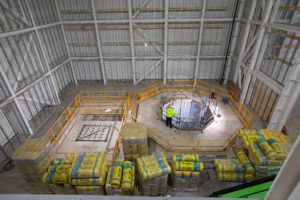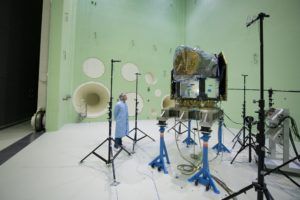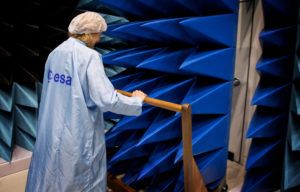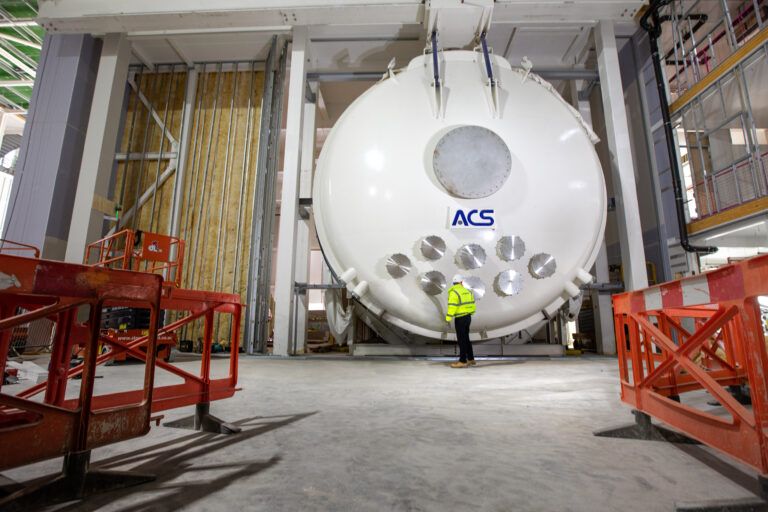by Frank Millard
With the advent of smaller satellites and the prospect of cheaper launches, the huge economic potential and many societal benefits of satellite technology has re-focused the attention of government and funding into space technology across the world.
As a result, testing infrastructure and facilities are being improved – facilities which aim to recreate as closely as possible the environmental conditions a satellite will experience during launch and in space.
A prime example is the UK Government, which is aiming to capture 10% of the global space market by 2030 and is funding upgrades to testing facilities to facilitate that growth as part of that commitment.
National facilities
The £104 million (US$144 million) National Satellite Test Facility (NSTF) is being built at the Rutherford Appleton Laboratory (RAL) site in Oxfordshire, UK. Due to be complete in July and to open next year, Covid-19 has created challenges, but remarkably only delayed the project by a couple of days.
The NSTF will provide environmental testing facilities and services for satellites, including satellite preparation rooms, an acoustic testing simulator and electromagnetic capability. It is one of a set of co-located facilities for environmental testing of space payloads and satellites that weigh up to 7,000kg (15,432 lbs).
“The NSTF offers sovereign, large-scale space test facilities for the first time in the UK. There is demand for this kind of facility domestically and we are also anticipating demand from customers based outside the UK,” says Sean Stewart, National Satellite Test Facility programme manager, STFC (Science and Technology Facilities Council) RAL Space.
The NSTF was designed as a single integrated facility to meet all of the requirements for testing a satellite before it is launched, with room for expansion to match the anticipated growth in demand. “The NSTF will reduce the need for users to move their satellite between different locations, saving time and money,” says Stewart.
Within the NSTF moving a satellite from the vacuum chamber to the vibration facility is a 70m (230ft) journey inside an environmentally controlled building. To carry out these two tests elsewhere in the UK or Europe would require the satellite to be packed into a specialist transport container and driven from one site to another, creating a logistical burden and risks.
After it is completed, the NSTF will go through a 12 month commissioning period before it is ready to accept commercial customers from summer 2022. Matt Fletcher, head of environmental test at STFC RAL Space says that the building is almost complete and that equipment is starting to arrive: “Our final steps are to finish the building, integrate all the equipment and perform acceptance testing. We then embark on the characterization and full technical commissioning stage which lasts approximately one year.”
Equipment highlights

The NSTF’s three-axis vibration facilities have been set at floor level so that the satellites can be put into position faster and technicians can work on them more easily. Stewart says, “The combined electromagnetic compatibility and antenna measurement system chamber has a built-in hypoxic plant to artificially raise the elevation of the facility to around 3000m (1,000ft) by reducing the percentage of oxygen in the air. This also minimizes the possibility of a satellite spontaneously combusting during high-power testing.
“Our Direct Field Acoustic Noise testing facility is being designed to operate at 146dBA with a capacity to operate up to 160dBA if required. This is considerably louder than a rock concert but will be contained within a 15m x 15m (50ft x 50ft) square room.
“For centre of gravity and moments of inertia measurement we have a new type of machine suitable for satellites of up to six tonnes, which will deliver results in hours rather than the days it takes using traditional measuring methods.”
The NSTF features clean rooms for large satellite preparation and solar array deployment. The facility also includes a large thermal vacuum chamber with 7m x 12m (23ft x 40ft) of internal usable space, installed during June last year, an EMC test facility and antenna measurement system, a dedicated vertical and horizontal vibration test facility, mass property test equipment, and the provision to perform acoustic testing. “The facility has been designed to run two test campaigns simultaneously, with the building designed around a central hub to ensure that the satellite can be moved seamlessly through the different tests,” says Fletcher.
The mass property equipment is innovative in that it characterizes the inertial properties of the satellite through gently wobbling the satellite.
Fletcher says, “All of the inertial properties can then be captured at the same set-up. Existing techniques require a longer time and different set-ups to gather this information.
“Test time is often under significant pressure, and saving time and money is important to the users.”
Acoustic testing

Acoustic testing will be performed using direct field acoustic noise. In Europe a reverberant room is commonly used for this purpose, although the direct field method is used commonly in the USA. “The benefit is that the equipment is portable and can be flexibly configured to be tailored to the needs of each user,” says Fletcher.
NSTF will provide Direct Field Acoustic Noise (DFAN) testing, a relatively new technique that uses a very large array of loudspeakers and powerful amplifiers. DFAN can be conducted in a standard room and sized according to the particular spacecraft being tested. Previous to this it was necessary to build a dedicated and highly specialised reverberant room which was expensive and inflexible.
The DFAN loudspeaker system requires precise control to prevent damage to the satellite. This is achieved by having many monitoring microphones which measure the sound field and allow precise control over the level and distribution of the acoustic energy. NSTF has recently recruited a specialist numerical modeler who will help to build computer models of the DFAN systems so that tests can be conducted and refined in the computer before a real satellite is exposed.
EMC test
Matthew Oldfield, EMC group leader at STFC RAL Space reveals that the facility includes a 17.6m x 17.6m x 14m (58ft x 58ft x 46ft) shielded, anechoic chamber with 7m x 10m (23ft x 33ft) clear aperture main access door. The temperature and humidity is controlled and it is both electrically and mechanically isolated from the main building. The walls and ceiling are lined with RAM (radar absorbing material) with removable RAM tiles for the floor. High specification EMC test equipment is able to perform tests to the ECSS-E-ST-20-07C standard, or MIL-STD-461, including radiated tests up to 40GHz. This includes a high power wall and a hypoxic fire-retardant system and thermal camera to safely perform satellite auto-compatibility tests where the on-board transmitters are operating at high power. There is also a vertical planar near-field scan system with a 12m x 12m (39ft x 39ft) scan area to fully characterize satellite antenna performance over the frequency range 500MHz to 75GHz.

ESTEC upgrades
Meanwhile in the Netherlands, a 350m3 (12,360ft³) clean room and a building for micro-vibration testing are currently being built at the ESTEC (European Space Research and Technology Centre), Europe’s largest satellite testing facility.
The new clean room will offer extra space to host satellites as they come on site, plus sensitive micro-vibration measurement facilities to characterize the low vibration generated by mechanisms mounted on board satellites. In addition, a corner of a new separate building, which has a special foundation to prevent vibrations, will be used for the micro-vibration testing. This building will be open before the end of next year. In addition, last December an upgrade to ESTEC’s mechanical data acquisition system, covering vibration, acoustic and shock testing was completed.
The ESTEC Test Centre has the facilities and equipment needed to do all of the necessary qualification testing required to conduct space missions. Gaetan Piret, head of the ESTEC testing division says, “We have a vibration facility capable of handling satellites from a few kilograms to a few tons. There is an acoustic chamber to reproduce the noise of the rockets and a mass property machine to measure the weights, centre of gravity and polar of inertia of
a specimen.
“To simulate space we have three vacuum chambers, starting from 5m3 [176m3] to the largest, which is 2,400m3 [84,755ft3] Inside these we can reproduce vacuums as well as very cold or very hot temperatures.
“The largest chamber also has an artificial sun, so we can recreate when a spacecraft is close to the sun. This has been upgraded for Bepi Columbo, so we can simulate the higher intensity of the sun it will experience. We will go to nearly 8.5 times one solar constant for that mission.
“Finally, we have the electrical chamber, where we do two types of tests. Electromagnetic compatibility tests ensure that the equipment on board the satellite will not interfere with each other or the rocket. There is also a facility that checks the communications antennae. We also have a number of large clean rooms for storing and preparing satellites in between tests.”
Recently engineers at ESTEC have developed new testing techniques in fields such as micro-vibration. “Many of the instruments mounted on satellites are sensitive to vibration. Vibration in the satellite from a mechanism such as a solar array will disturb a camera or radar.” says Piret. “We need to characterize any equipment that is generating vibration to assess the effect on the satellite.
“If we find the level of vibration is unacceptable we install damping material. Our facility can measure micro forces below a hundred millinewton.”
Another new test method recently developed is in the field of thermal elastic deformation. “A satellite is assembled on Earth, where everything should be at 20˚C (68˚F) in the clean room. But during operation its temperature will vary – if the satellite is in the sun or in a shadow, or if a system in the satellite is operating.
“This temperature variation deforms the satellite’s structure, only by microns, but enough to affect optical instruments. It is therefore important to know how much deformation takes place when the temperature varies.
“We use infrared cameras to do temperature mapping and videogrammetry. The cameras used are standard COTS units, but because they go into the vacuum chamber they are placed in canisters.”
This involves the placing of the targets on the structure and using two cameras to record it as the ambient temperature is varied. The deformation of the structure is measured using changes to the position of the stickers. “These cameras have to be calibrated carefully so they do not pick up changes in the camera itself,” explains Piret.
Clean rooms
Equipment and facilities in ESTEC can be modified to recreate the environments that just a single research mission may face, including on planets such as Mars, Mercury or Jupiter. “Modifying a facility can take several years. We started making changes to the testing facilities used for Bepi Columbo four years before we began testing it,” says Piret.
“We have already started planning for missions to the Moon and Mars. To be able to work in these environments it will have to be able to recreate the wind and dust that exists on the surface.”
However, the general trend is for more small satellites, of a few hundred kilos each. These need to be tested quickly and inexpensively as possible so the missions can be commercially viable. This creates a need to reduce costs, which can be achieved through automation.
“Copernicus, which is six lots of 24 satellites will impact what we are doing in the future. Copernicus satellites are high priority, so in the coming five years European facilities will be very busy testing those.”





